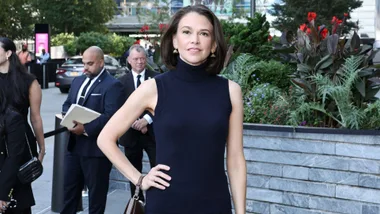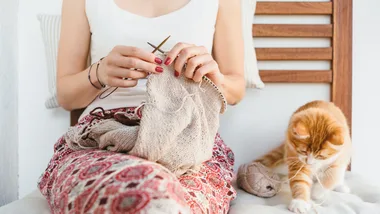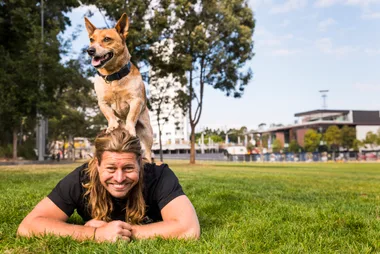Dame Stella Rimington, former head of British Intelligence, MI5 is the author of At Risk (Random House Australia), a stunning debut thriller and The Australian Women’s Weekly July Great Read. Q Hi, is it okay if I call you Stella? A Yes please do. Q You don’t use the title? A Not really – I find it’s a very strange title to have because not many people know what to say. They call me Dame Rimington and some people (laughing) call me Mrs Dame. Q What is the correct way to address you? A It’s Dame Stella but people don’t like to use your Christian name so they get very embarrassed (laughing). Q Congratulations on At Risk, I couldn’t put it down. A I’m pleased to hear it. Q I think I read it in about one and a half days – I put the rest of my life aside to finish it. A Oh great (laughing)! That’s good to hear. Q I read that you dreamed for many years to write a thriller, was that because working in intelligence you had access to good material for plots or that you simply wanted to write? A It was to do with my job. Anybody who works in the intelligence world has got access to good material – a number of good plots are around. It’s not the kind of thing you can do while you’re working there. It’s only since I’ve retired – and I’ve been 8 years out of that field, that I can do something about it. I think it was mainly the character – I had the female intelligence officer in At Risk, in my head for a long time. Q She was brewing in the back of your brain? A She was (laughing). In parts she’s me and through the years she’s brewed and changed. Q A good plot doesn’t necessarily translate into good story? A It doesn’t and I started writing a book with my autobiography. That was my first go at anything, but you know in my former profession and as a public servant you do an awful lot of writing, although it is different, more about accuracy and precision than about story and character. So I didn’t know whether I could. I did have some help. We had a little team of three with my publisher and a journalist called Luke Jennings, so it’s been a rather fascinating creative process with all three of us striking sparks off each other. Q The Government tried to stop your autobiography being published, did you have to have this book cleared before it could be published? A Yes, it’s been read by my former colleagues in MI5. I am bound I think forever, to show them anything that could have any connection with my former employment. They had no problem with it and understand that it is entirely imaginary. Q They didn’t ask you to delete or change anything? A Not with this one, although they did with the autobiography. It was entirely stirred up that furore, entirely unnecessary. If you read it you will realise there’s nothing in it that is in any sense damaging to national security. I wasn’t going to spend 27 years working to defend our security and then blow the secrets. Q At Risk gave me the feeling that I was getting an insider’s account of the intelligence world, normally a forbidden and deeply secretive place – was my instinct right? A Yes, At Risk is broadly the way things are done. Information comes in as snippets and has to be put together. In a way, in the world of intelligence you never actually know the full story and you’ve got to interpret what you know and try and find out a bit more. So it’s an accretion of information which is in the plot and yes that is authentic. And the relationships are broadly authentic, the way different bits of the system get involved with each other, the intelligence service and the police and the military. All that is broadly the way things work. Q Did you go somewhere quiet to write the book or do it at home? A Both. I have a little house in East Anglia which is where a lot of At Risk, is set. Me and my dog go up there where it’s quiet. I do find it difficult to concentrate on writing when there’s lots of other things going on. I think you’ve got to create a quiet space. Q What’s your dog’s name? A Stanley. He’s a springer spaniel. He’s lovely but he’s 13 and a half now and becoming quite an old man. Q I see you writing in a picturesque little cottage overlooking green fields – is that correct? A The little cottage is right, it’s in a village and not far from the coast where a lot of the action in At Risk takes place. Q I liked the way you got into the mind of the main character, intelligence officer Liz Carlyle and into the head of the terrorists and their meticulous planning. A I think in a different world, the female terrorist could have been an intelligence officer. It’s two women with similar approaches, pitted against each other. One’s on one side, the other’s on the other. In the end, they kind of meet and you could say, merge together. So yes, it’s basically about women and the way they deal with different kinds of situations. Q When you set out to write the book what did you want to achieve? A I wanted to tell an exciting story that was relevant to the world as it is now. Lots of spy stories have been written about the cold war but I wanted it to be bringing the genre up to date, really. So that’s why I focussed on a terrorist plot. I also tried to show that the techniques of intelligence remained broadly the same. So I think there are links with spy stories of the past, like John le Carre. Q Generally spy stories are blokey, did you make the leads female to make it more accessible to women? A They’re about James Bond type men and I am very conscious of that, because of who I am and my background. However, the world of intelligence has quite a lot of women it. Q What percentage? A When I left MI5 8 years ago, the service was 50-50 men and women. Admittedly they weren’t evenly spread through the hierarchy, there were more men near the top. But of course now there’s another woman now running MI5. I think what people don’t understand is how much female involvement there is in the world of intelligence, certainly with the domestic intelligence there are a lot of women, and they are doing all the front line work now. When I started out, it was the exact opposite – you could only do the support work. But that’s not true any more so in a sense sub-consciously, those were the things I had in my mind when I was writing At Risk. Q Do women bring certain qualities to intelligence work that men don’t have? A Difficult to say, it’s horses for courses and there are different kinds of men and different kinds of women. The important thing is diversity of approach, so you do need men and women. And women do have certain different qualities. They tend to be quite reflective, analytical, they’re more prepared to sit back and think. And don’t have to be out doing. I think there’s a place for both. When you’re doing operational work it is very important that you have a choice of different kinds of people, whoever the enemy is, at any given time. Diversity is important – men and women, different ethnic backgrounds, the whole of humanity needs to be reflected somehow or other. Q Liz Carlyle is very intuitive? A Yes, not everybody who works in intelligence has that. Some are extremely clever and can analyse information very accurately but you do need a kind of intuition and you need experience, you need to know the kind of things to look for. You need a combination of skills and Liz certainly has some of them. If you compare her with the character Bruno Mackay who is a stereotype of the other kind. There’s a contrast between the two. He’s more a James Bond type. Q Liz Carlyle has a sex life but there’s none of the steamy sex scenes you associate with the spy genre? A I was trying to make the point that working in the intelligence world messes up your private life, almost inevitably. You start these relationships but they don’t really get anywhere because they’re founded on this need for secrecy and the double life that you’re forced to lead with your job. I thought in a way that having any sex scenes would mess up that point really. I wanted also to develop this other delicate relationship Liz has with her boss in the service, Weatherby. Q There’s a chemistry between them? A Yes and I hope that maybe in the next one I might be able to keep that going so it’s important not to get too explicit. Suggestion is better and also too many sex scenes take the tension away from the plot which is what I really wanted to focus on. Q It must have been difficult to be married and unable to tell the person you’re supposed to be closest to, about aspects of your life? A In fact I have separated from my husband although on friendly terms. We live separately and have done so since the early eighties, so my marriage didn’t really last. There are marriages that do last of course and it’s easier now for people to talk to their partners. When I first joined I was told you musn’t tell anybody, not even your parents where you worked and that made for very difficult circumstances. That element of difficult personal relationships is very important and it’s one I wanted to make because of my own background. Q You believe the intelligence world needs to be brought out more into the open? A I think particularly with domestic security, there is a great need to relate to the public because you depend on the public to a large extent to be alert, particularly nowadays with the terrorist threat. When I joined, the service was very, very covert. I think it’s extremely important to get a better relationship with the public and you can only really do that by being more open. In my time as director general we started a more open approach. And that’s gone on. MI5 now has a website and it updates the website and puts all kinds of info on it including what the current terrorist threats are. Obviously there are limits, there are always going to be because you can’t have an intelligence service that puts everything into the public domain, so there’s a balance to be struck and just where the balance is causes a great deal of debate still. Q You were the first director general of MI5 to be publicly named – and photographed – you were pipped at the front door carrying some shopping bags? A Yes and that’s another reason why I thought the secrecy was absolutely ludicrous – I mean, you had all these journalists lurking outside, why not give them a proper photograph and get on with it? And that’s what we did but the reason why we didn’t when I was first named, is that the IRA was very active on the streets of London and of course there was a terrorist threat, so balance was important because you couldn’t be open and expose people to danger. Q You have two grown up daughters and a granddaughter to whom you dedicate the book? A Yes a five year old granddaughter and she and I are very close. In fact we are going away together today to the little town in East Anglia I’ve been telling you about. Q How concerned were for you family’s safety when you were in charge of MI5? A With the publicity associated with my appointment and the press fuss that resulted from that (as the first woman ever to run MI5), that was a very difficult time. I had one daughter living at home then and one at university and in the end we had to sell our house and move because it wasn’t really safe for us to go on living there. It was particularly difficult for my youngest daughter because she was at home and we had to go underground and live secretly. Q For how long? A About three years. That was very difficult for her as a teenager, not knowing who she should bring home. Q Or who she could trust socially? A Yes and she couldn’t give out our number so it was a problem for her. She had a little car at the time and it was registered under a false name and when she went out in the evening she’d always say, ‘what if I had an accident? What if the police come. Tell me? Who am I?’ So this was something you didn’t want to expose your teenage child too really, but it went with the territory. Q I imagine you’re proud of what you achieved but it must be with a feeling of relief that you are out of it now? A Yes. I take a very great interest from the sidelines in what’s going on but it is very difficult now for them because there are always threats. When I was there, the IRA was our main anxiety. But now it is very difficult for them. It’s a very diffuse threat. And I just feel I’m rather glad I’m not responsible now. They are very good at what they do, my former colleagues, but nobody can be 100% certain, obviously. Q To many of us, the world feels like a more dangerous place now – would you agree? A I feel that the world’s always been a dangerous place really and people who think that there are moments when we are more safe are a bit deluded. I think we are more aware of the dangers nowadays. I lived through WWII, the cold war, IRA terrorism. These days we just know more about it with 24 hour a day news and the greater openness. Q I suppose that’s reassuring, especially with the Olympic Games in Athens coming up? A Don’t forget there’s been terrorism in Europe since the late fifties. It is I suppose a bit less predictable now. With the old league at least we knew what they wanted and one could predict what their target would be. The current terrorist threat seems so diffuse. It’s not clear I don’t think, precisely what they’re after and what they might attack. Q I have this horrible feeling that Osama Bin Laden is a highly intelligent man and that makes me feel more anxious. A Mmm. Terrorists often have been quite clever. I don’t know enough about Bin Laden to know if he is, but it’s the unpredictablility of it really. And the feeling that with this lot of terrorists who are prepared to die, then you’re facing a different threat – that of suicide bombing which is very much more difficult to deal with. In the old days terrorists were prepared to kill other people, then they wanted to escape – they didn’t want to kill themselves. Q At Risk is the first of a series? A Yes I’ve started on the next one with Liz Carlyle and one or two of the other characters and I want to try and develop Liz in a way and bring in other themes, not only focusing on terrorism. Q As well as writing books, you’re a director of Marks and Spencer – it obviously hasn’t crossed your mind to slow down in your retirement? A Well, (laughing) I shall soon be 69 and so I think I will probably start slowing down as 70 approaches, but I like to keep going and I’m the kind of person who fills a void, so if I have less to do then I need to find something to do. I think writing is going to fill the gap when I drop my two directorships. Q Where you were born and what did your parents do for a living? A I was born in London in 1935 and the war came quite quickly so we rapidly moved out of London . My father was a civil engineer and worked in the steel business so unfortunately when we moved out of London, we always seemed to move to places that were priorities for German bombing. So I spent quite a lot of my early childhood in an air raid shelter, listening to bombs dropping. That was a kind of pretty unsettling start to life. My father came from Yorkshire and my mother from Lancashire so they were northerners, and I think something of that, the sort of temperament of the north is in my personality. My father believed in hard work and no slacking. There wasn’t time to mess about, you’ve got to get on with it. so I think that has infected my personality … you know, you’ve got to get on with things. Q Were you an only child? A No I have a brother who is 3 years older than me. He is retired now but he was also a civil engineer, largely for the railways. Q Your star sign is? A Taurus. Q Stella Rimington loves … A The countryside, walking, my granddaughter, my family. Q Dislikes? A Hypocrisy, exaggeration. Q Hopes? A To have a happy and fulfilling old age. Q We all hope that. A Yes (laughing).
Newsletter conversion description. Get the latest in your inbox.



































